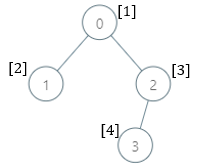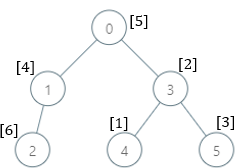2003. Smallest Missing Genetic Value in Each Subtree
Description
There is a family tree rooted at 0 consisting of n nodes numbered 0 to n - 1. You are given a 0-indexed integer array parents, where parents[i] is the parent for node i. Since node 0 is the root, parents[0] == -1.
There are 105 genetic values, each represented by an integer in the inclusive range [1, 105]. You are given a 0-indexed integer array nums, where nums[i] is a distinct genetic value for node i.
Return an array ans of length n where ans[i] is the smallest genetic value that is missing from the subtree rooted at node i.
The subtree rooted at a node x contains node x and all of its descendant nodes.
Example 1:

Input: parents = [-1,0,0,2], nums = [1,2,3,4] Output: [5,1,1,1] Explanation: The answer for each subtree is calculated as follows: - 0: The subtree contains nodes [0,1,2,3] with values [1,2,3,4]. 5 is the smallest missing value. - 1: The subtree contains only node 1 with value 2. 1 is the smallest missing value. - 2: The subtree contains nodes [2,3] with values [3,4]. 1 is the smallest missing value. - 3: The subtree contains only node 3 with value 4. 1 is the smallest missing value.
Example 2:

Input: parents = [-1,0,1,0,3,3], nums = [5,4,6,2,1,3] Output: [7,1,1,4,2,1] Explanation: The answer for each subtree is calculated as follows: - 0: The subtree contains nodes [0,1,2,3,4,5] with values [5,4,6,2,1,3]. 7 is the smallest missing value. - 1: The subtree contains nodes [1,2] with values [4,6]. 1 is the smallest missing value. - 2: The subtree contains only node 2 with value 6. 1 is the smallest missing value. - 3: The subtree contains nodes [3,4,5] with values [2,1,3]. 4 is the smallest missing value. - 4: The subtree contains only node 4 with value 1. 2 is the smallest missing value. - 5: The subtree contains only node 5 with value 3. 1 is the smallest missing value.
Example 3:
Input: parents = [-1,2,3,0,2,4,1], nums = [2,3,4,5,6,7,8] Output: [1,1,1,1,1,1,1] Explanation: The value 1 is missing from all the subtrees.
Constraints:
n == parents.length == nums.length2 <= n <= 1050 <= parents[i] <= n - 1fori != 0parents[0] == -1parentsrepresents a valid tree.1 <= nums[i] <= 105- Each
nums[i]is distinct.
Solutions
Solution: Depth-First Search
- Time complexity: O(n)
- Space complexity: O(n)
JavaScript
js
/**
* @param {number[]} parents
* @param {number[]} nums
* @return {number[]}
*/
const smallestMissingValueSubtree = function (parents, nums) {
const n = parents.length;
const result = Array.from({ length: n }, () => 1);
const oneNode = nums.indexOf(1);
if (oneNode === -1) return result;
const tree = Array.from({ length: n }, () => []);
const visited = new Set();
let currentNode = oneNode;
let minMiss = 1;
let prevNode = -1;
for (let node = 1; node < n; node++) {
const parent = parents[node];
tree[parent].push(node);
}
const visitNode = node => {
visited.add(nums[node]);
for (const neighbor of tree[node]) {
visitNode(neighbor);
}
};
while (currentNode !== -1) {
visited.add(nums[currentNode]);
for (const node of tree[currentNode]) {
if (node === prevNode) continue;
visitNode(node);
}
while (visited.has(minMiss)) {
minMiss += 1;
}
result[currentNode] = minMiss;
prevNode = currentNode;
currentNode = parents[currentNode];
}
return result;
};